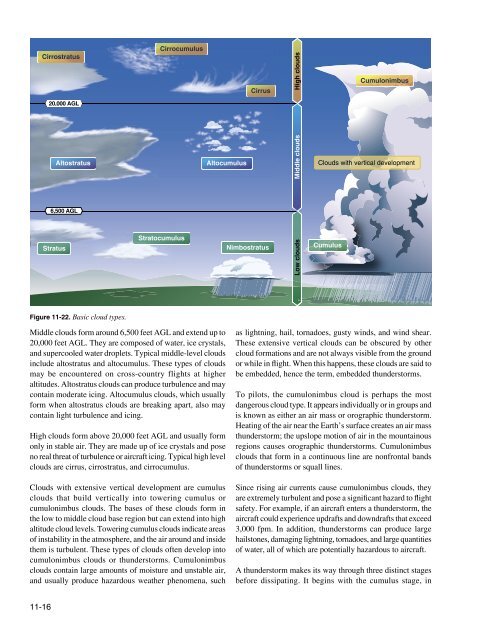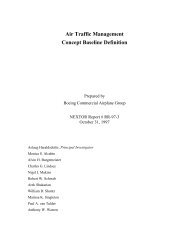Chapter 11: Weather Theory - FAA
Chapter 11: Weather Theory - FAA
Chapter 11: Weather Theory - FAA
You also want an ePaper? Increase the reach of your titles
YUMPU automatically turns print PDFs into web optimized ePapers that Google loves.
Cirrostratus20,000 AGLAltostratus6,500 AGLStratusCirrocumulusStratocumulusAltocumulusCirrusNimbostratusLow clouds Middle clouds High cloudsCumulusCumulonimbusClouds with vertical developmentFigure <strong>11</strong>-22. Basic cloud types.Middle clouds form around 6,500 feet AGL and extend up to20,000 feet AGL. They are composed of water, ice crystals,and supercooled water droplets. Typical middle-level cloudsinclude altostratus and altocumulus. These types of cloudsmay be encountered on cross-country flights at higheraltitudes. Altostratus clouds can produce turbulence and maycontain moderate icing. Altocumulus clouds, which usuallyform when altostratus clouds are breaking apart, also maycontain light turbulence and icing.High clouds form above 20,000 feet AGL and usually formonly in stable air. They are made up of ice crystals and poseno real threat of turbulence or aircraft icing. Typical high levelclouds are cirrus, cirrostratus, and cirrocumulus.Clouds with extensive vertical development are cumulusclouds that build vertically into towering cumulus orcumulonimbus clouds. The bases of these clouds form inthe low to middle cloud base region but can extend into highaltitude cloud levels. Towering cumulus clouds indicate areasof instability in the atmosphere, and the air around and insidethem is turbulent. These types of clouds often develop intocumulonimbus clouds or thunderstorms. Cumulonimbusclouds contain large amounts of moisture and unstable air,and usually produce hazardous weather phenomena, suchas lightning, hail, tornadoes, gusty winds, and wind shear.These extensive vertical clouds can be obscured by othercloud formations and are not always visible from the groundor while in flight. When this happens, these clouds are said tobe embedded, hence the term, embedded thunderstorms.To pilots, the cumulonimbus cloud is perhaps the mostdangerous cloud type. It appears individually or in groups andis known as either an air mass or orographic thunderstorm.Heating of the air near the Earth’s surface creates an air massthunderstorm; the upslope motion of air in the mountainousregions causes orographic thunderstorms. Cumulonimbusclouds that form in a continuous line are nonfrontal bandsof thunderstorms or squall lines.Since rising air currents cause cumulonimbus clouds, theyare extremely turbulent and pose a significant hazard to flightsafety. For example, if an aircraft enters a thunderstorm, theaircraft could experience updrafts and downdrafts that exceed3,000 fpm. In addition, thunderstorms can produce largehailstones, damaging lightning, tornadoes, and large quantitiesof water, all of which are potentially hazardous to aircraft.A thunderstorm makes its way through three distinct stagesbefore dissipating. It begins with the cumulus stage, in<strong>11</strong>-16
















